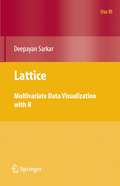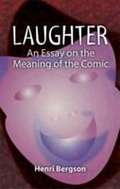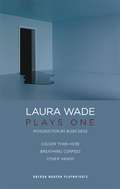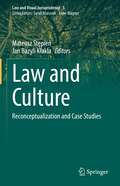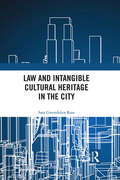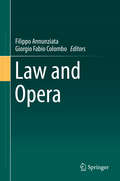- Table View
- List View
Lattice: Multivariate Data Visualization with R (Use R!)
by Deepayan SarkarWritten by the author of the lattice system, this book describes lattice in considerable depth, beginning with the essentials and systematically delving into specific low levels details as necessary. No prior experience with lattice is required to read the book, although basic familiarity with R is assumed. The book contains close to 150 figures produced with lattice. Many of the examples emphasize principles of good graphical design; almost all use real data sets that are publicly available in various R packages. All code and figures in the book are also available online, along with supplementary material covering more advanced topics.
Laugh Lines: Caricaturing Painting in Nineteenth-Century France
by Julia LangbeinLaugh Lines: Caricaturing Painting in Nineteenth-Century France is the first major study of Salon caricature, a kind of graphic art criticism in which press artists drew comic versions of contemporary painting and sculpture for publication inwidely consumed journals and albums. Salon caricature began with a few tentative lithographs in the 1840s and within a few decades, no Parisian exhibition could open without appearing in warped, incisive, and hilarious miniature in the pages of the illustrated press.This broad survey of Salon caricature examines little-known graphic artists and unpublished amateurs alongside major figures like Édouard Manet, puts anonymous jokesters in dialogue with the essays of Baudelaire, and holds up thematerial qualities of a 10-centime album to the most ambitious painting of the 19th century. This archival study unearths colorful caricatures that have not been reproduced until now, drawing back the curtain on a robust culture of comedyaround fine art and its reception in nineteenth-century France.
Laugh Lines: Caricaturing Painting in Nineteenth-Century France
by Julia LangbeinLaugh Lines: Caricaturing Painting in Nineteenth-Century France is the first major study of Salon caricature, a kind of graphic art criticism in which press artists drew comic versions of contemporary painting and sculpture for publication inwidely consumed journals and albums. Salon caricature began with a few tentative lithographs in the 1840s and within a few decades, no Parisian exhibition could open without appearing in warped, incisive, and hilarious miniature in the pages of the illustrated press.This broad survey of Salon caricature examines little-known graphic artists and unpublished amateurs alongside major figures like Édouard Manet, puts anonymous jokesters in dialogue with the essays of Baudelaire, and holds up thematerial qualities of a 10-centime album to the most ambitious painting of the 19th century. This archival study unearths colorful caricatures that have not been reproduced until now, drawing back the curtain on a robust culture of comedyaround fine art and its reception in nineteenth-century France.
Laughing at Architecture: Architectural Histories of Humour, Satire and Wit
by Michela RossoIn a media-saturated world, humour stands out as a form of social communication that is especially effective in re-appropriating and questioning architectural and urban culture. Whether illuminating the ambivalences of metropolitan life or exposing the shock of modernisation, cartoons, caricature, and parody have long been potent agents of architectural criticism, protest and opposition.In a novel contribution to the field of architectural history, this book outlines a survey of visual and textual humour as applied to architecture, its artefacts and leading professionals. Employing a wide variety of visual and literary sources (prints, the illustrated press, advertisements, theatrical representations, cinema and TV), thirteen essays explore an array of historical subjects concerning the critical reception of projects, buildings and cities through the means of caricature and parody. Subjects range from 1750 to the present, and from Europe and the USA to contemporary China. From William Hogarth and George Cruikshank to Osbert Lancaster, Adolf Loos' satire, and Saul Steinberg's celebrated cartoons of New York City, graphic and descriptive humour is shown to be an enormously fruitful, yet largely unexplored terrain of investigation for the architectural and urban historian.
Laughing at Architecture: Architectural Histories of Humour, Satire and Wit
by Michela RossoIn a media-saturated world, humour stands out as a form of social communication that is especially effective in re-appropriating and questioning architectural and urban culture. Whether illuminating the ambivalences of metropolitan life or exposing the shock of modernisation, cartoons, caricature, and parody have long been potent agents of architectural criticism, protest and opposition.In a novel contribution to the field of architectural history, this book outlines a survey of visual and textual humour as applied to architecture, its artefacts and leading professionals. Employing a wide variety of visual and literary sources (prints, the illustrated press, advertisements, theatrical representations, cinema and TV), thirteen essays explore an array of historical subjects concerning the critical reception of projects, buildings and cities through the means of caricature and parody. Subjects range from 1750 to the present, and from Europe and the USA to contemporary China. From William Hogarth and George Cruikshank to Osbert Lancaster, Adolf Loos' satire, and Saul Steinberg's celebrated cartoons of New York City, graphic and descriptive humour is shown to be an enormously fruitful, yet largely unexplored terrain of investigation for the architectural and urban historian.
Laughing Fit to Kill: Black Humor in the Fictions of Slavery
by Glenda CarpioReassessing the meanings of "black humor" and "dark satire," Laughing Fit to Kill illustrates how black comedians, writers, and artists have deftly deployed various modes of comedic "conjuring"--the absurd, the grotesque, and the strategic expression of racial stereotypes--to redress not only the past injustices of slavery and racism in America but also their legacy in the present. Focusing on representations of slavery in the post-civil rights era, Carpio explores stereotypes in Richard Pryor's groundbreaking stand-up act and the outrageous comedy of Chappelle's Show to demonstrate how deeply indebted they are to the sly social criticism embedded in the profoundly ironic nineteenth-century fiction of William Wells Brown and Charles W. Chesnutt. Similarly, she reveals how the iconoclastic literary works of Ishmael Reed and Suzan-Lori Parks use satire, hyperbole, and burlesque humor to represent a violent history and to take on issues of racial injustice. With an abundance of illustrations, Carpio also extends her discussion of radical black comedy to the visual arts as she reveals how the use of subversive appropriation by Kara Walker and Robert Colescott cleverly lampoons the iconography of slavery. Ultimately, Laughing Fit to Kill offers a unique look at the bold, complex, and just plain funny ways that African American artists have used laughter to critique slavery's dark legacy.
Laughing matters: Understanding film, television and radio comedy
by John Mundy Glyn WhiteLaughing Matters takes an analytic approach to film, television and radio comedy and provides an accessible overview of its forms and contexts. The introduction explains the value of studying comedy, concisely outlines the approach taken and summarises the relevant theories. The subsequent chapters are divided into two parts. The first part examines the specific forms comedy has taken as a constant and key element in film and broadcast comedy from their origins to the present. The second part shows how the genre gravitates towards contentious issues in British and American culture as it finds humour in the boundaries of class, gender, sexuality, race and logic. The authors cover silent cinema comedy including Chaplin, Lloyd and Keaton, sound film comedies including the Marx Brothers and Laurel and Hardy, Romantic film comedy, radio, television situation and sketch comedy, comedy and genre (including parody and spoof), animations from cartoons to CGI, issues of gender and sexuality from drag comedy to queer reading, issues of taste and humour from Carry On to contemporary 'gross-out' , and issues of race and ethnicity including a case study of African-American screen comedy. Numerous opportunities for following up are highlighted and advice on further reading, writing academically about comedy and an extensive bibliography add to the value of this textbook.
Laughter: An Essay on the Meaning of the Comic
by Henri BergsonIn this great philosophical essay, Henri Bergson explores why people laugh and what laughter means. Written at the turn of the twentieth century, Laughter explores what it is in language that makes a joke funny and what it is in us that makes us laugh. One of the functions of humor, according to Bergson, is to help us retain our humanity during an age of mechanization. Like other philosophers, novelists, poets, and humorists of his era, Bergson was concerned with the duality of man and machine. His belief in life as a vital impulse, indefinable by reason alone, informs his perception of comedy as the relief we experience upon distancing ourselves from the mechanistic and materialistic. "A situation is always comic," Bergson notes, "if it participates simultaneously in two series of events which are absolutely independent of each other, and if it can be interpreted in two quite different meanings. " The philosopher's thought-provoking insights (e. g. , "It seems that laughter needs an echo. Our laughter is always the laughter of a group. ") keep this work ever-relevant as a thesis on the principles of humor.
Laughter in Occupied Palestine: Comedy and Identity in Art and Film
by Chrisoula LionisThough the current political situation in Palestine is more serious than ever, contemporary Palestinian art and film is becoming, paradoxically, increasingly funny.In Laughter in Occupied Palestine, Chrisoula Lionis analyses both the impetus behind this shift toward laughter and its consequences, arguing that laughter comes as a response to political uncertainty and the decline in nationalist hope. Revealing the crucial role of laughter in responding to the failure of the peace process and ongoing occupation, she unearths the potential of humour to facilitate understanding and empathy in a time of division. This is the first book to provide a combined overview of Palestinian art and film, showing the ways in which both art forms have developed in response to critical moments in Palestinian history over the last century. These key moments, Lionis argues, have radically transformed contemporary Palestinian collective identity and in turn Palestinian cultural output.Mapping these critical junctions - beginning with the Balfour Declaration of 1917 to the Oslo Accords in 1993 - she explores the historical trajectory of Palestinian art and film, and explains how to the failure of the peace process has led to the present proliferation of humour in Palestinian visual culture.
Laughter in Occupied Palestine: Comedy and Identity in Art and Film (International Library of Visual Culture)
by Chrisoula LionisAlthough the political situation in Palestine is more serious than ever, contemporary Palestinian art and film are, paradoxically, becoming more humorous in their responses. Laughter in Occupied Palestine looks deeply into this trend, and is the first book to provide an overview of Palestinian art and film, showing the ways in which both art forms have developed in reaction to critical moments in Palestinian history over the last century. Chrisoula Lionis analyzes both the impetus behind this shift toward humour and its consequences, arguing that it has flourished amid political uncertainty and the decline in nationalist hope. Revealing the crucial role of jokes in responding to the failure of the peace process and ongoing occupation, she unearths the potential of laughter to facilitate understanding and empathy in a time of conflict and division.
Laura Knight: A Life
by Barbara C. MordenLaura Knight (1877-1970) was one of the most distinguished women artists of the early 20th century with an international reputation. This much-anticipated biography appears at a time of renewed interest in Dame Laura's extensive repertoire. Laura Knight: A Life probes beneath the myths and fictions that have and continue to be woven around the artist. This highly readable and objective biography covers her early years in Nottingham; relationship with her husband Harold; life in the artists colonies of Staithes on the North Yorkshire coast, Laren in Holland and Newlyn in Cornwall; Laura's subsequent immersion in the worlds of the ballet, the circus, the theatre and her travels in Europe and America; her work as a designer of theatrical costume, posters and ceramics; and her role as Official War Artist during World War 11 and recorder of the Nuremberg Trials in 1945-46. The author does more than merely draw the solid lines of Dame Laura's professional and public identity for the reader, she fills in the background, expresses the light and colour of Laura Knight's vibrant personality and, by also exploring the darker shades of her character, gives this portrait of the artist depth and perspective. If you read just one biography of Laura Knight it should be this one.
Laura Wade: Plays One (Oberon Modern Playwrights)
by Laura Wade‘If one of the problems facing new playwrights is the expectation that each of their plays should be similar in style, Wade…proved that you could radically change both form and content… Not every writer delivers on their early promise. As this collection clearly shows, Wade certainly has.’ Aleks Sierz, from his IntroductionCOLDER THAN HERE‘Laura Wade’s play is a 90-minute masterpiece, a jewel, dark but translucent. It is a play of love, death and grief: the grief that is hardest to bear, because it begins before the loved one dies.’ Sunday TimesBREATHING CORPSES‘The tension, the emotions and the sense of absurdity and fear are brilliantly handled... A terrifying tour de force.’ Sunday TimesOTHER HANDS‘This is an extraordinary feat – a vicious satire with a heart of gold – wrought with peculiar subtlety and intelligence.’ The Spectator
Laurent Cantet (French Film Directors Series)
by Martin O'ShaughnessyLaurent Cantet is of one France’s leading contemporary directors. In a series of important films, including Human Resources, Time Out, Heading South, The Class and Foxfire, he takes stock of the modern world from the workplace, through the schoolroom and the oppressive small town to the world of international sex tourism. His films drive the hidden forces that weigh on individuals and groups into view but also show characters who are capable of reflection and reaction. If the films make their protagonists rethink their place in the world, they also challenge the positions of the viewer and the director. This is what makes them so worthy of study. Combining a fine eye for detail with broad contextual awareness, this book gives an account of all Cantet’s works, from the early short films to the major works. Martin O’Shaughnessy is a leading international writer on French cinema,especially in film and politics.
Laurent Cantet (French Film Directors Series)
by Martin O'ShaughnessyLaurent Cantet is of one France’s leading contemporary directors. In a series of important films, including Human Resources, Time Out, Heading South, The Class and Foxfire, he takes stock of the modern world from the workplace, through the schoolroom and the oppressive small town to the world of international sex tourism. His films drive the hidden forces that weigh on individuals and groups into view but also show characters who are capable of reflection and reaction. If the films make their protagonists rethink their place in the world, they also challenge the positions of the viewer and the director. This is what makes them so worthy of study. Combining a fine eye for detail with broad contextual awareness, this book gives an account of all Cantet’s works, from the early short films to the major works. Martin O’Shaughnessy is a leading international writer on French cinema,especially in film and politics.
The Lavender Companion: Enjoy the Aroma, Flavor, and Health Benefits of This Classic Herb
by Jessica Dunham Terry Barlin VesciA celebration of lavender featuring stunning photographs; favorite recipes for the kitchen, pantry, and body care products; along with fascinating lore and gardening guidance from a destination lavender farm. Lavender has long been a favorite herb with its amazing, resinous fragrance; calming qualities; and unique flavor for seasoning food. This lavishly photographed celebration of the beloved herb, written by an acclaimed lavender farmer and cooking instructor, is brimming over with inspiration and ideas for bringing the fragrance and flavor of lavender into daily life. The book profiles the most popular lavender varieties and their recommended uses, along with the history, lore, and traditional medicinal uses. More than 40 recipes showcase lavender in delicious dishes from the kitchen as well homemade craft and body products. Tips for success with lavender in the garden complete this perfect gift for every lavender lover.
L'avventura (BFI Film Classics)
by Geoffrey Nowell-SmithThis study provides a detailed account of the 1960s film, 'L'avventura', arguing that in order to appreciate its greatness it is necessary to understand not only that the film is a classic but also that it represents a revolution in cinema.
L'avventura (BFI Film Classics)
by Geoffrey Nowell-SmithThis study provides a detailed account of the 1960s film, 'L'avventura', arguing that in order to appreciate its greatness it is necessary to understand not only that the film is a classic but also that it represents a revolution in cinema.
Law and Culture: Reconceptualization and Case Studies (Law and Visual Jurisprudence #5)
by Mateusz Stępień Jan Bazyli KlaklaDivided into three parts, this book examines the relationship between law and culture from various perspectives, both theoretical and empirical. Part I outlines the framework for further considerations and includes new, innovative conceptualizations of two ideas that are essential to the topic of law and culture: legal culture and customary law. Both of these reappear later in the more empirically oriented chapters of Parts II and III. Part II includes chapters on the relationships between law, customs, and culture, drawing heavily on the tradition and achievements of the anthropology of law and touching on important problems of multiculturalism, legal pluralism, and cultural defense. It focuses on the more intangible meaning of culture, while Part III addresses its more material, tangible aspects and the issue of cultural production, as well as its intersection with law.
Law and Intangible Cultural Heritage in the City
by Sara Gwendolyn RossWith disappearing music venues, and arts and culture communities at constant risk of displacement in our urban centers, the preservation of intangible cultural heritage is of growing concern to global cities. This book addresses the role and protection of intangible cultural heritage in the urban context. Using the methodology of Urban Legal Anthropology, the author provides an ethnographic account of the civic effort of Toronto to become a Music City from 2014-18 in the context of redevelopment and gentrification pressures. Through this, the book elucidates the problems cities like Toronto have in equitably protecting intangible cultural heritage and what can be done to address this. It also evaluates the engagement that Toronto and other cities have had with international legal frameworks intended to protect intangible cultural heritage, as well as potential counterhegemonic uses of hegemonic legal tools. Understanding urban intangible cultural heritage and the communities of people who produce it is of importance to a range of actors, from urban developers looking to formulate livable and sustainable neighbourhoods, to city leaders looking for ways in which their city can flourish, to scholars and individuals concerned with equitability and the right to the city. This book is the beginning of a conservation about what is important for us to protect in the city for future generations beyond built structures, and the role of intangible cultural heritage in the creation of full and happy lives. The book is of interest to legal and sociolegal readers, specifically those who study cities, cultural heritage law, and legal anthropology.
Law and Intangible Cultural Heritage in the City
by Sara Gwendolyn RossWith disappearing music venues, and arts and culture communities at constant risk of displacement in our urban centers, the preservation of intangible cultural heritage is of growing concern to global cities. This book addresses the role and protection of intangible cultural heritage in the urban context. Using the methodology of Urban Legal Anthropology, the author provides an ethnographic account of the civic effort of Toronto to become a Music City from 2014-18 in the context of redevelopment and gentrification pressures. Through this, the book elucidates the problems cities like Toronto have in equitably protecting intangible cultural heritage and what can be done to address this. It also evaluates the engagement that Toronto and other cities have had with international legal frameworks intended to protect intangible cultural heritage, as well as potential counterhegemonic uses of hegemonic legal tools. Understanding urban intangible cultural heritage and the communities of people who produce it is of importance to a range of actors, from urban developers looking to formulate livable and sustainable neighbourhoods, to city leaders looking for ways in which their city can flourish, to scholars and individuals concerned with equitability and the right to the city. This book is the beginning of a conservation about what is important for us to protect in the city for future generations beyond built structures, and the role of intangible cultural heritage in the creation of full and happy lives. The book is of interest to legal and sociolegal readers, specifically those who study cities, cultural heritage law, and legal anthropology.
Law and Opera
by Filippo Annunziata Giorgio Fabio ColomboThis book explores the various connections between Law and Opera, providing a comprehensive, multinational, and multidisciplinary (with approaches from jurists, philosophers, musicologist, historians) resource on the subject. Further, it makes a valuable contribution to studies on law and the humanities. While, for example, the relationship between law and literature has been extensively researched, the relationship between Law and Opera remains largely overlooked. The book approaches the topic from three perspectives in three main sections: Law in Opera, Law on Opera, and Law around Opera.
Law and Order (BFI TV Classics)
by Charlotte BrunsdonL?aw and Order is a police story, a crime series, a courtroom drama and a prison film. Written by G. F. Newman, directed by Les Blair and produced by Tony Garnett, Law and Order challenges the comfortable world of the television police series to reveal the proximity of police and villains in a world of deals, set-ups and mutually advantageous financial arrangements. The 1978 series, shot in a low-key naturalistic style, was so controversial when first broadcast that the BBC could neither repeat nor export it, and BBC news teams were excluded from prisons. Now available on DVD, Law and Order is, Charlotte Brunsdon argues, an 'absent classic' in the history of British television drama.This carefully-researched and elegantly-argued study offers close analysis of the four films, while also showing how Law and Order comments on contemporary criminal justice scandals and exploring the outrage that the broadcasts caused the year before the election of the 1979 Thatcher government. It uses interviews with the makers of the programmes to show how the films were made, and original archive research about the BBC's response to the subsequent protests in a period of political instability. Charlotte Brunsdon argues that now the shocking claims of the series have been accepted as 'true enough', it is time to recognise its aesthetic achievement, and restore Law and Order to its place within the canon of great British television drama. Law and Order offers a much bleaker vision of 1970s policing than Life on Mars and re-runs of The Sweeney, and this study shows how the series draws on the tradition of 'serious television drama' and the popular police series to change ideas about both television serial drama and British criminal justice.
Law and Practice for Architects
by Robert Greenstreet Karen Greenstreet Brian SchermerProvides a framework for understanding of the legal, contractual and procedural implication of architectural practice. The book acts as a useful aide-memoire for students and practitioners based on the premise that smooth legal administration will provide the conditions under which client relations can be constructive and good design can be achieved.
Law and Practice for Architects
by Robert Greenstreet Karen Greenstreet Brian SchermerProvides a framework for understanding of the legal, contractual and procedural implication of architectural practice. The book acts as a useful aide-memoire for students and practitioners based on the premise that smooth legal administration will provide the conditions under which client relations can be constructive and good design can be achieved.
Law, Art and the Commons
by Merima BruncevicThe concept of the cultural commons has become increasingly important for legal studies. Within this field, however, it is a contested concept: at once presented as a sphere for creativity, democratic access and freedom of speech, but one that denies property rights and misappropriates the public domain. In this book, Merima Bruncevic takes up the cultural commons not merely as an abstract notion, but in its connection to physical spaces such as museums and libraries. A legal cultural commons can, she argues, be envisioned as a lawscape that can quite literally be entered and engaged with. Focusing largely on art in the context of the copyright regime, but also addressing a number of cultural heritage issues, the book draws on the work of Deleuze and Guattari in order to examine the realm of the commons as a potential space for overcoming the dichotomy between the owner and the consumer of culture. Challenging this dichotomy, it is the productive and creative potential of law itself that is elicited through the book’s approach to the commons as the empirical basis for a new legal framework, which is able to accommodate a multitude of interests and values.
